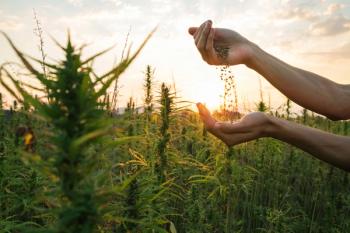
The Science Behind LED Lights

With grow light technology constantly advancing, Noah Miller, CEO of Black Dog LED, discusses the research behind grow light technology and its future in cannabis.
The mechanics of grow light technology is continuously advancing to better suit the needs of growers. Through these constant improvements, cannabis cultivators are able to better provide the proper necessities for the best cannabis growth. Here, Noah Miller, CEO of Black Dog LED, delves into the world of grow light technology and how it will continue to evolve.
How did you and your company get involved in the cannabis industry?
Noah Miller: Black Dog LED was purpose-built to be involved in the cannabis industry from the very beginning—we did not pivot into the industry. The founder wanted a quality light that was less dangerous to use in a home environment than high-pressure sodium vapor (HPS) lights—the most common type of lighting available at the time being used to flower cannabis. He tried some of the early light-emitting diode (LED) grow lights on the market, but was sorely disappointed, and felt he could do better. Fast forward 10 years and we are on our fifth generation of lights and have developed the most unique spectrum focused on growing high-quality cannabis.
What is the correct spectrum for flowering cannabis plants?
Miller: This question is almost impossible to answer since the permutations available to us are too many to test in a lifetime. Creating the perfect spectrum is something that may take another 50 years, however, with the research available to us we have been able to engineer a spectrum that accomplishes the goals of most indoor cannabis cultivators. These primary goals are, of course, yield and quality, but also include controlling plant morphology (growth pattern) so that the plant is easier to control and flower indoors as well as other benefits we can achieve with a properly engineered spectrum.
What is the difference between your LED grow lights and others that are on the market?
Miller: The main difference between our lights and the others is the countless hours of scientific research spent in identifying what makes cannabis plants grow and flower. Our team comes from a scientific background and we understand that different wavelengths of light result in different effects within a plant. As such, we sought to develop a grow light that focused on flower yield and quality, which differs from other spectrums that focus on growth, which would be a better fit for leafy greens.
Can you provide further detail on the lighting spectrum your grow light technology produces?
Miller: In the past, grow lighting has been provided by technologies designed to illuminate areas for humans, which also happened to grow plants. Fluorescent/induction lights work for very short plants, but are inefficient and lack the intensity necessary to grow taller plants. High-intensity discharge (HID) lighting provides this intensity and better efficiency but limits plant growth due to inadequate spectral coverage and intense heat. All of these technologies were designed for illuminating areas for people, not plants. LED technology allows the creation of lighting with both high efficiency and a completely tuned light spectrum.
Our product is the result of many years of research—and even more importantly years of researching cannabis grows—to fine-tune an LED light spectrum for growing plants that maximize yield, quality, and efficiency.
We started by researching photosynthetic reactivity, which is how efficiently a plant can carry out photosynthesis at different wavelengths of light. By carefully controlling ratios of different colors of light we can not only efficiently fuel plant growth but also affect their morphology, creating denser, more-compact plants that waste less of their energy creating stems, leaving more energy for flowers and fruits.
Photosynthesis isn't the only light-driven process in plants. Secondary metabolites (compounds) are created in a process called photomorphogenesis, many based on colors of light not used directly for photosynthesis. Our spectrum includes ultraviolet (UV) and infrared (IR) light to stimulate plants to create these quality-enhancing compounds. While UV and IR are both outside of the parabolic aluminized reflector (PAR) lighting region, they are present in natural sunlight and are critical to achieving plants' full potential.
How did you research LED grow lights in the cannabis industry? What other research is your company working on related to cannabis cultivation?
Miller: We researched our lights against competitors in highly-controlled testing environments, growing the same strain of plants, in rooms of the same dimensions, and focused on ensuring that all variables were controlled as much as possible so that the only notable difference would be the effectiveness of the light and its spectrum. We’ve repeated these tests hundreds of times, focusing on different variables like leaf surface temperature, to hone in on our final product which, we believe, is the most advanced spectrum ever created and is backed by research. We’ve also recently opened an R&D center focused on Farm Bill—compliant cannabis hemp flower, focusing on the unique light spectrum needed to grow hemp—a close cousin of cannabis but with lower tetrahydrocannabinol (THC) yield.
What should people know to be able to determine the ideal LED grow light setup or what will work best for their plants?
Miller: Each grower’s setup is unique, and a large part of our work involves visiting our customers’ grow sites in advance to view the facility, map out their grow room, and set up lights in a pattern that maximizes lighting exposure to boost yield per square foot.
To do this, we’ve developed a propriety light mapping software. This is completely different from the rest of the market who use traditional computer-aided design (CAD) software which is designed for buildings and general construction but not tailored to the unique needs of cannabis cultivators.
And, of course, each grower must be cognizant of the laws and regulations within their state, county, and town as they can vary dramatically across the US and globally.
How do you address the different limits or electricity caps that some states (such as Massachusetts) have instituted for cannabis cultivation sites?
Miller: Black Dog LED is uniquely positioned to help with these challenges, and we support further environmental stewardship in the cannabis industry around cultivation. By working closely with our customers, we have found that we can still help them achieve their cultivation goals while working within the confines of different state regulations. This entails a discovery phase upfront that explores the needs and goals of an organization as these can be different. Yes, all operations want to grow cannabis, but their unique goals can help dictate the lighting deployment and affect energy use.
By taking the time to learn about each commercial project allows us to ensure the success of the customer. Most customers are surprised by our desire to dig into the details, as they are used to organizations that just want to sell them lights, but we feel this partnership with the customer is critical in helping the customer get the most out of their lighting infrastructure purchase.
Are there any differences in working with cultivators in the US compared to Canada?
Miller: Canada tends to have larger, more well-funded operations than in the United States due to the legal climate up there. The rush to build out in Canada early on occurred primarily before LED had really caught on in the commercial cannabis industry. Further, there has been a major correction in the market with some operations even being mothballed recently. We feel that Canada will have a large opportunity to retrofit newer LED technology in the next 1-3 years. The operators that make this transition to the new tech will have a competitive advantage over the companies producing cannabis at a higher cost due to older, less efficient technology.
What are the next steps Black Dog LED plans on taking in growing their LED line? Will the company expand to other areas with cannabis production?
Miller: We’re always adjusting our lights based on our latest research findings and hope to announce our latest product soon. That said, our immediate focus is getting through COVID-19 which has been one of the most impactful events of our lives that we’ll look back on in the same view as The Great Depression.
We’re also continuing to develop research based on hemp flower and have recently announced our hemp grow room, which is currently taking a majority of our focus.
How has the COVID-19 pandemic affected your company?
Miller: Like many others, COVID-19 forced us to rethink how we approach business in a way that protects our employees while keeping the business running. In the immediate sense, that meant shifting to remote work several weeks before the state began its mandates—and we were fortunate to already have a strong work from home culture and processes in place. As for business, we’ve actually seen an increase in our home growing kits due to everyone having more time to devote to new hobbies, including home growing and indoor gardening.
How have you assisted in aiding the community during the COVID-19 pandemic?
Miller: Being a smaller company with somewhat limited resources. We have focused on our community of growers and especially our Black Dog LED family of employees. For the grower community, we have doubled down on providing education online with no paywall or any purchase requirements. We want to do anything we can do to help people cultivate safely at home during this time. For our employees, we have given them the ability to participate in making decisions about how we address these unprecedented times as well as allowing them to make their own decisions based on their level of comfort and personal risk. While the time has been difficult, our team has truly risen to the occasion and we couldn’t ask for a better group of people to be working as we navigate these challenges.
What methods of protection are you taking to keep workers and customers safe?
Miller: Like many others, we have transitioned to primarily remote operations with only essential activities such as shipping and receiving taking place in-person, and only when necessary. Remote work has long been a part of our company’s DNA since, living in Colorado, snowstorms and blizzards will often shut down roadways and force us to work from home anyway. We’re also limiting nearly all in-person meetings—opting instead for Zoom calls which are nearly as effective—and do not plan on attending trade shows or large gatherings until it is safe to do so.
Newsletter
Unlock the latest breakthroughs in cannabis science—subscribe now to get expert insights, research, and industry updates delivered to your inbox.



